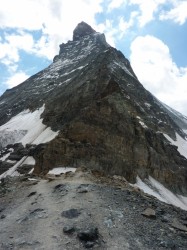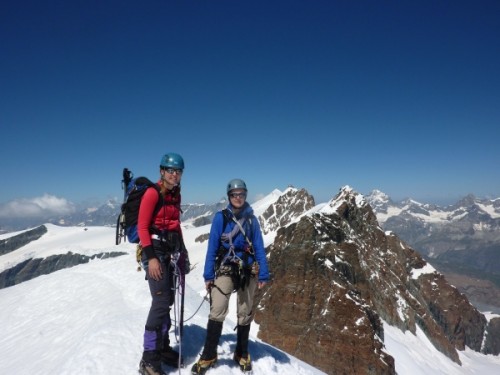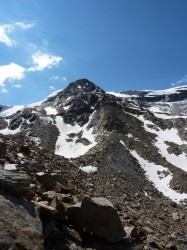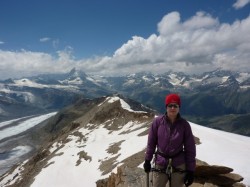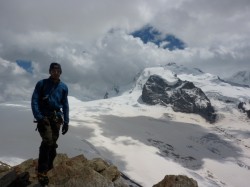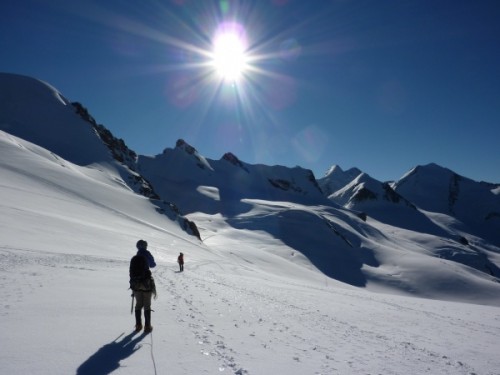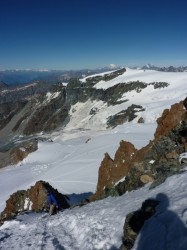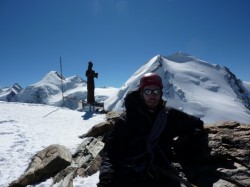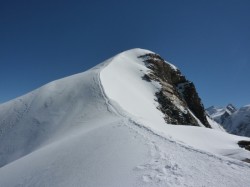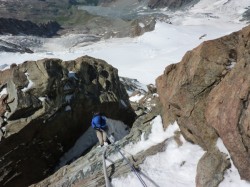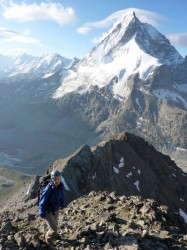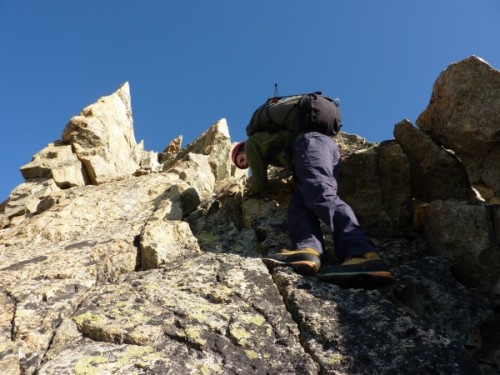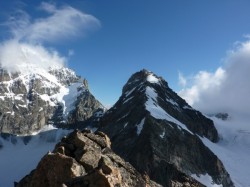Monte Rosa & Mattertal 2012
Maria and I were lucky enough to have 3 weeks in the Alps this year. We based ourselves in Täsch (a few km away from Zermatt), and managed to get ourselves up a reasonable few mountains during the trip (in between the fondu eating and beer drinking).
Ober Rothorn (3414m)
Just a walk, and we used a cable car up to about 3000m, but the Ober Rothorn is a nice viewpoint, and was a useful bit of early acclimatisation. 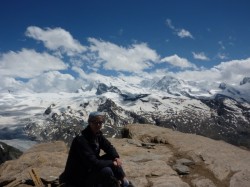
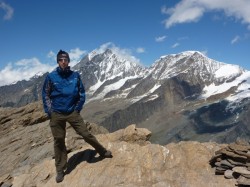
Riffelhorn (2928m) - Skyline, AD+
With great views of Lyskamm, Breithorn and the Matterhorn, this was a very pleasant spot to do a bit of rock-climbing. Skyline was an enjoyable route, but we weren't convinced it warranted the AD+ grade - it was quite short, and made up of a few short steep pitches (the hardest being grade IV) interspersed with scrambling sections. Descent was by an F route, which was scrambly but very straightforward.
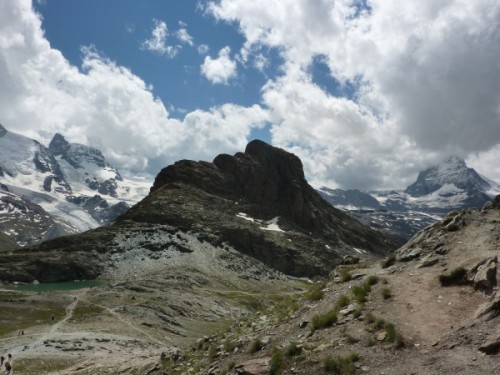
Stockhorn (3532m) - NW ridge, PD
This was to be our first route on a big mountain of the holiday, with about 1400m ascent, some rock climbing and a snow arête to finish. The guidebook suggested it was the best route on the mountain, but unfortunately the quality seems to have suffered quite a bit from glacial retreat since the guidebook was written. Crossing the moraines of the the Findel glacier was unpleasant, the snowfield we were meant to cross to get to the ridge didn't really exist, and when we got to the rocky ridge it turned out to be a tottering pile of choss! In nearly a km of ridge I'd say there was about 25m of enjoyable rock climbing... To be fair, the summit snow slopes were pleasant enough, and the peak is a great viewpoint across to the various peaks of the Monte Rosa. The way down was quite a nice scrambly walk along the Hohtälligrat and past the top station of the Gornergrat mountain railway, but by this time we were probably too knackered and fed up of loose rock to enjoy it...
Pollux (4092m), SW ridge, PD+ or AD (depending on which guidebook you believe)
Making use of the first cable car to Klein Matterhorn of the day, a few of the peaks on the western side of the Monte Rosa group can be climbed in a day from the valley. This makes it easier to fit more routes into a short period of time (no need for a hut walk-in day), and with the weather a bit patchy we found it easier to grab relatively short windows of good conditions. It did mean we had to deal with the queue-jumping antics of the summer skiers though - it took some self-restraint to resist wielding our ice axes in anger...
Setting out from the top lift station, across the Breithornplateau, an amazing panorama of peaks opens out, with the Breithorn ridge on the left, then the twins Castor and Pollux, and Lyskamm and Dufourspitze beyond.
The SW ridge of Pollux started out with a steep snowy couloir, then some scrambling on the ridge before the crux section appeared. This consists of traversing a slab, then climbing a gully (which was quite icy), and finally a steep wall to reach the summit snow arete, and (bizarrely) a statue of the Madonna + child. The whole of this 25m section has been equipped with fixed ropes, which makes it easier than the AD grade in the guidebook suggests. The bolts that the ropes are fixed to do make for handy runners though.
The final 100m to the summit consist of a nice curving snow ridge, ending with some more amazing views of the rest of the Monte Rosa group. We descended the same way we came up, abseiling the crux section (just about possible on a 50m rope with the aid of a bit of rope stretch!).
A few rest days...
After a couple of big mountains we were in need of a couple of days off, and the weather was still a bit patchy, so we spent a few days doing gentler walks in the valley, eating ice cream and taking lots of pictures of the Matterhorn (when it came out of the clouds).
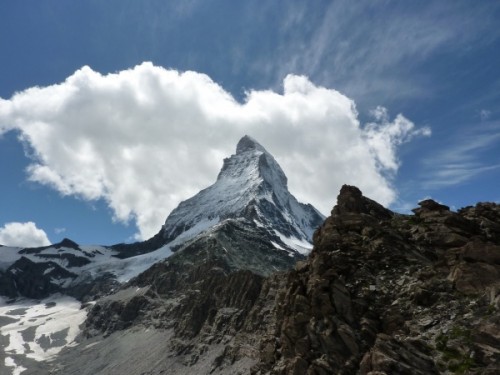
We had then intended to make use of the Klein Matterhorn lift again to do a half-traverse of the Breithorn, but (amazingly for something Swiss) it was out of order, so we chose instead to walk to the Schönbiel hut to have a go at the Schönbielhorn and the Pointe de Zinal.
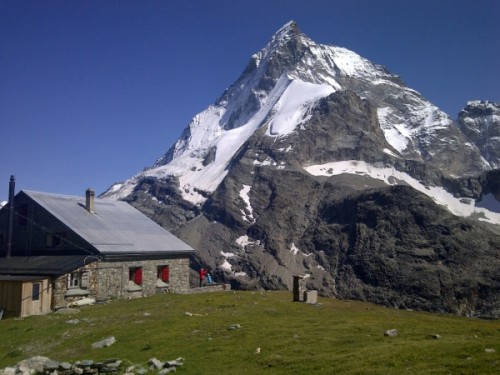
Schönbielhorn (3472m), traverse, PD-, and Pointe de Zinal (3789m), S ridge, AD
Setting off from the hut at dawn, the approach to the Schönbielhorn was a steep slog, initially on a good path, but that later gave way to horrendous scree. Once we gained the south ridge the going became pleasanter, with easy, albeit slightly loose, scrambling leading to the summit.
From the summit, we descended the north ridge to the col between this hill and the Pointe de Zinal. After the col, we started up the Pointe de Zinal south ridge - a mixture of rock scrambling and snowy terrain.
The weather had been fairly cold for July, and at around 3,700m the rock became iced up, so we decided to get the rope out. A couple of easy pitches later, we reached the first of a series of gendarmes that marked the final obstacle before the summit. However, it looked like some bad weather was obviously on its way in, and conscious that there was a lengthy descent across a crevassed glacier, we decided to head back down.
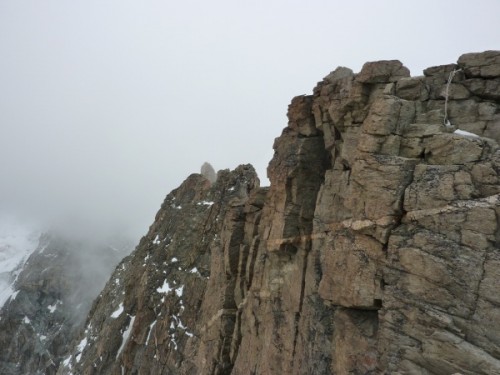
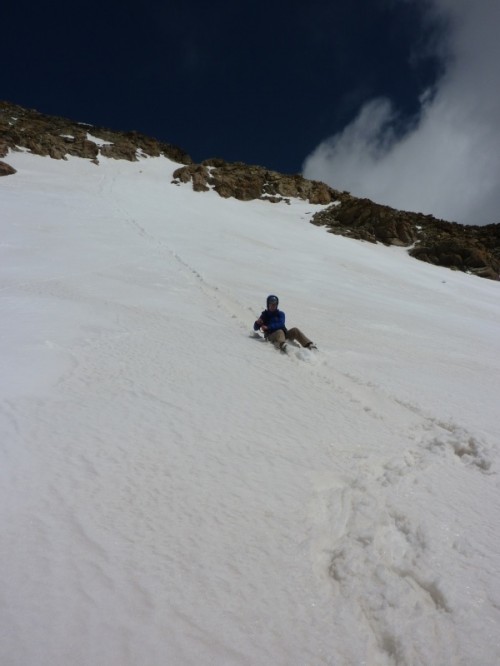
While descending one of the snowy sections we had climbed earlier, Maria slipped after putting her crampon on an unseen slab of rock beneath the snow, and commenced a rather swifter descent than intended. Luckily her first ever 'real life' ice-axe brake was successful, and she managed to stop the slide before hurtling down a cliff! The remainder of the descent was uneventful, although very tiring - it's always a longer walk out than it seemed on the way up!
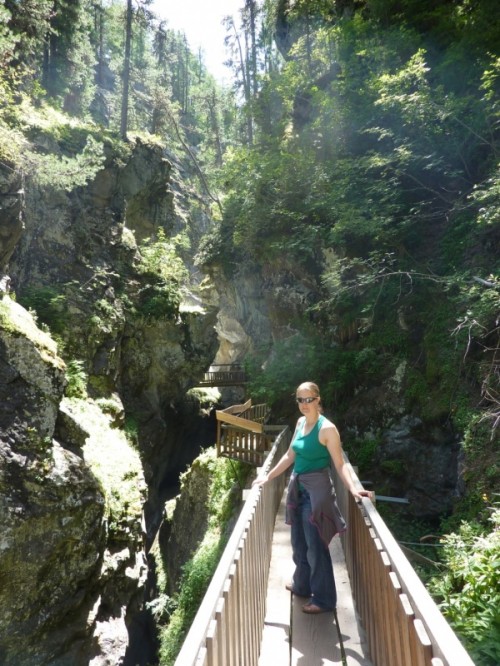
Another rest day - Gornerschlucht
Zermatt has lots of less adventurous things to do for tourists, and a visit to the Gornerschlucht (a gorge carved out by the glacier meltwater) was well worthwhile.
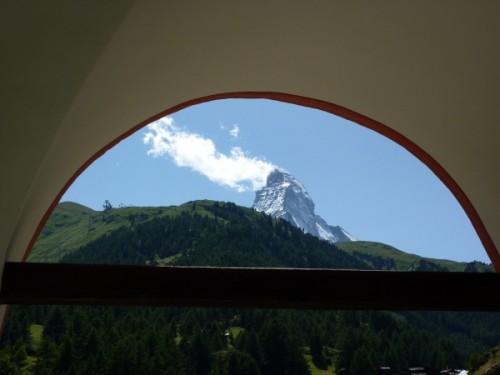
Breithorn (4164m) - half-traverse, starting up E ridge of Central Summit (4159m), AD
The half-traverse of the Breithorn takes in the most interesting climbing of the full traverse, but has the advantage of being doable in a day from the valley, again via an early lift to Klein Matterhorn. After joining the ridge just to the east of the central summit, you head west, climbing three prominent rock steps to the central summit.
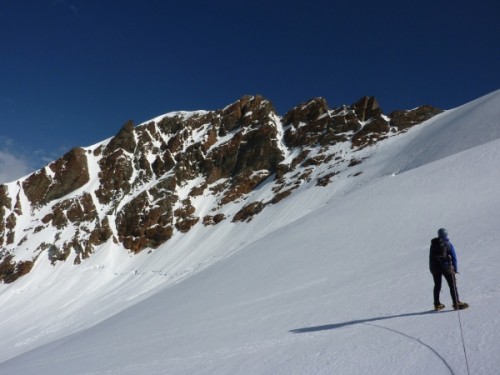
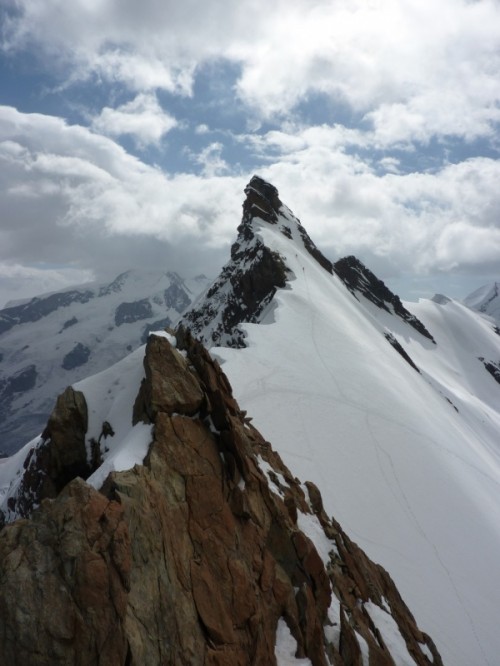
The climbing was excellent - mostly grade III, although the direct ascent of the first pinnacle was graded IV, and the quality and exposure were sustained throughout. Lots of groups avoided the hardest pitch via a snowy gully and some slabs to the left of the ridge, but we thought this missed out the best bit. The spectacular pitch climbed straight up a steep rib, before traversing out above the north face in a couple of extremely exposed moves. There were bolts, but not many, so it's definitely wise to bring a rack!
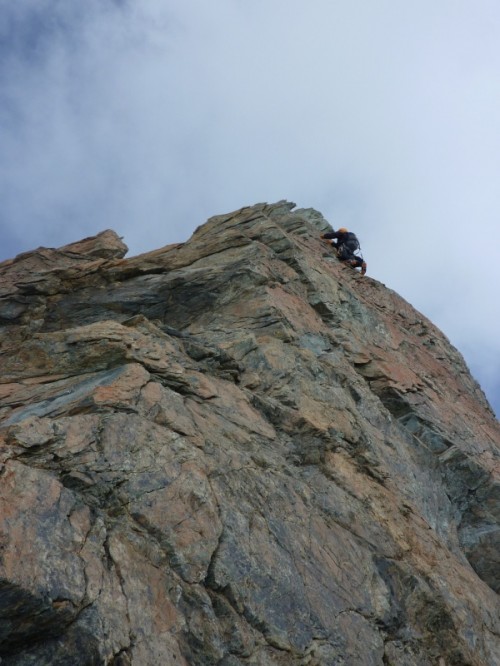
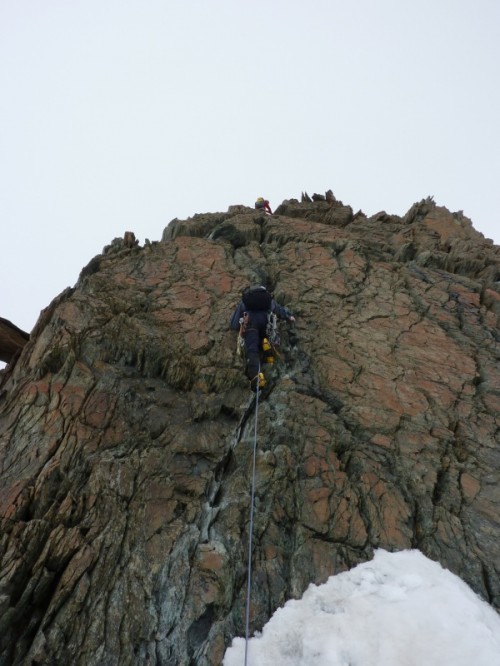
After the steep steps, the ridge narrowed to a beautiful snow and rock arete leading to the central summit, from where it was an easier walk along the ridge to the main (west) summit and down to Klein Matterhorn.
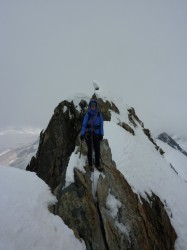
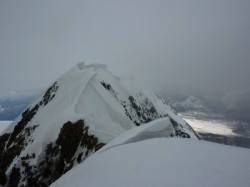
Castor (4223m) - ascent by WNW flank, PD+, and descent by SE ridge, F+
After another early morning lift to Klein Matterhorn, we walked past the Breithorn and Pollux before setting out up the WNW flank of Castor, the higher of the two twins. The ascent was a straightforward but reasonably steep snow slope, followed by a short narrow ridge to the summit, where we were greeted by some pretty special views of Lyskamm - the next day's objective. Our descent route followed the snowy SE ridge down to the Felikjoch, before turning south down the glacier to the Quintino Sella hut.
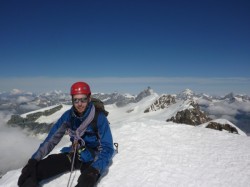
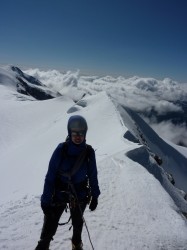
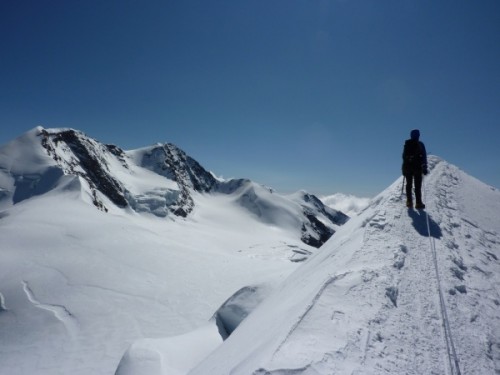
We must have been very well-acclimatised by this stage of the holiday, as we were about two hours ahead of guidebook time when we arrived at the hut at about 11:30am, leaving us with a whole afternoon to rest and chill out. The weather forecast had suggested we were in for a few days of settled weather, and the hut guardian seemed to agree that the Lyskamm was a great choice for the next day, so we were a bit surprised and concerned when it snowed for most of the afternoon, given the need for stable snow conditions advised by all the guidebooks. Luckily it cleared a bit during the evening, and there only seemed to be a thin layer of fresh snow, so the optimism started to return as we looked forward to the next day.
Lyskamm (4527m) - traverse W to E, AD
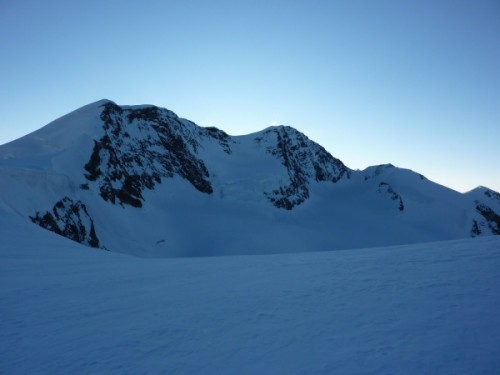
Described by Martin Moran as 'a majestic expedition', and the Alpine Club guidebook as 'one of the finest ridge traverses in the Alps', we had high hopes for this route and we were not disappointed. The ridge runs for about 4.5km from the Felikjoch in the West to the Lisjoch in the East, and for most of this distance it is a sensational snowy knife-edge with big cornices and huge drops either side (the N face is about 900m high and the S face around 500m). There's not much in the way of technical difficulties, but the position is astonishing and I can't think of any other route I've done with the same sustained sense of exposure.
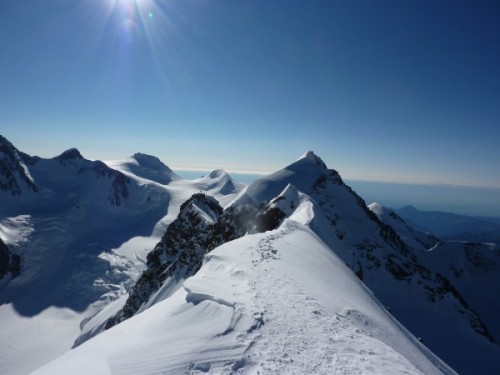
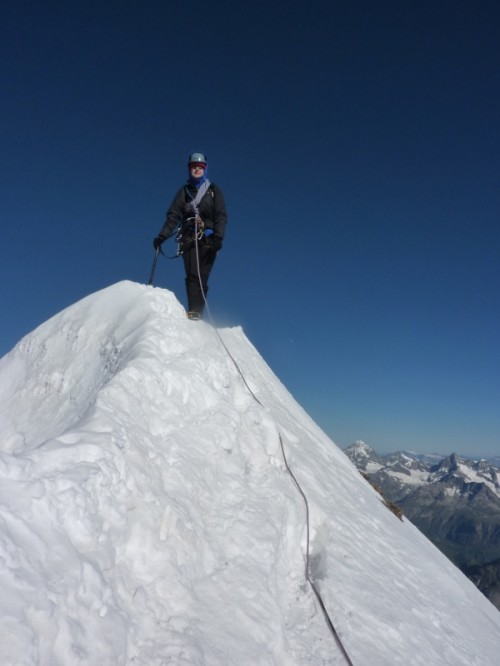
Throughout the route the sky was clear and the sun was shining, but the wind built up gradually through the day, and it was very cold. The low temperatures helped create nice firm snow conditions, but also left us with frozen camelbak tubes and therefore relying on the small bottle of juice to stay hydrated. The wind also added some extra excitement on the really narrow sections, and on the final ascent to the main (East) summit it was whipping spindrift into our faces as if we were in Scotland in winter!
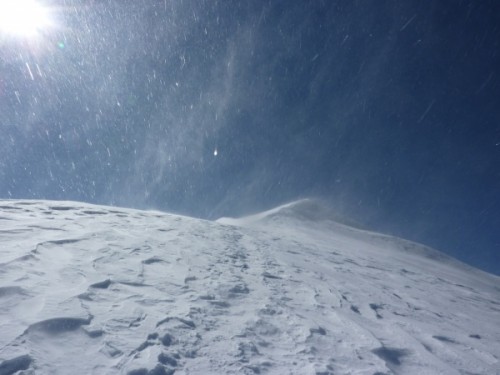
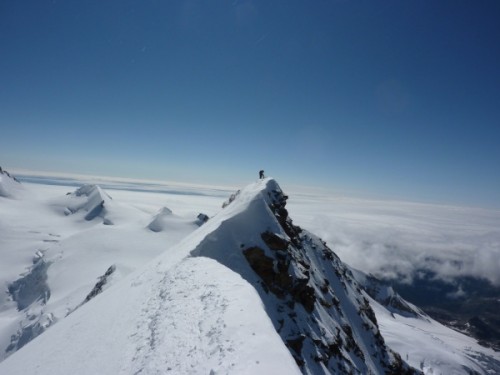
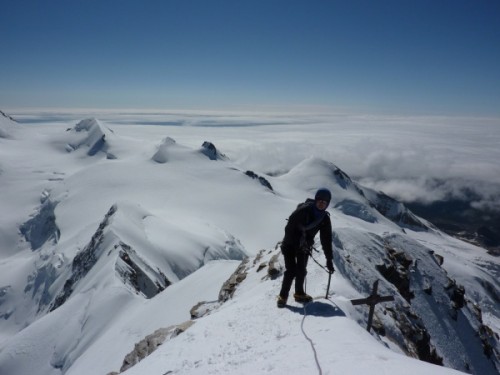
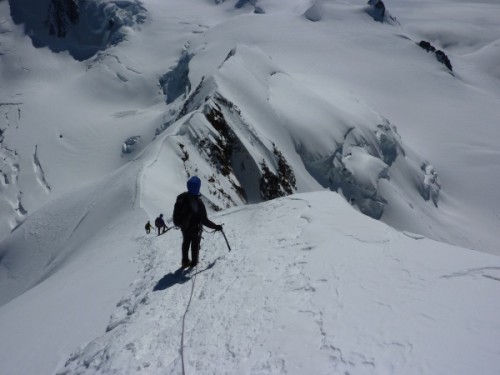
After descending the knife-edge East ridge, we reached the Lisjoch just as the weather seemed to be closing in. The strong winds had clearly brought some thick clouds in, and whiteout conditions quickly developed, leaving us with a choice to make. We had intended to ascend the normal route (F) to Signalkuppe (4554m), where we were to spend the night in the highest building in Europe - the Margherita Hut. However, the idea of ascending 350m on a heavily crevassed clacier in a whiteout, heading into the wind, did not appeal (!) so we considered alternatives. We decided to head south, towards the Gnifetti hut (at 3611m, over on the Italian side of the Monte Rosa group), keeping the Balmenhorn bivouac hut in the backs of our minds in case things got really bad. We both consider ourselves pretty competent navigators, but unfortunately however accurate your compass bearings are, if you fail to spot a crevasse in poor visibility you're in trouble, so the descent was quite unnerving as we cautiously made our way down into Italy. Part way down we found a few other climbers in a similar situation, but with local guides who knew the location of the crevasses, so we shamelessly followed them for a while. Arriving at the hut we apologised for not having booked, and were glad to hear they were only about half-full that night. We were also pleased to find out later on that the food served at the Gnifetti had gone from the worst we'd ever tasted at a hut 4 years ago to one of the best ever now!
Our change of location for the overnight scuppered our plans for the next day, which were to traverse the Zumsteinspitze and Dufourspitze on the way back to Zermatt. Instead we had a long walk up the Lis glacier to the Lisjoch at about 4250m, then down the Grenz glacier, past the Monte Rosa hut (a very impressive hut built a couple of years ago) and across to hop on the mountain railway down from Rotenboden. Despite not reaching any summits, this walk back to Switzerland involved about 800m ascent and 1600m descent - quite tiring after two nights spent at altitude and three days in a row where we'd got up at 5am or earlier...
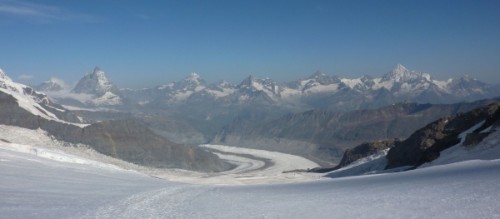
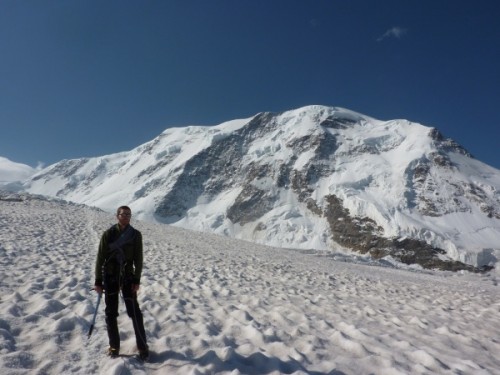
The last few days...
After that, we didn't really fancy any more big days out, but we met up with a few other York MC members, went out for a few beers, walked up to the Hörnli hut (well done to Sarah & Mike on their ascent of the Matterhorn the next day), and climbed Pollux again with Helen on our last day in Switzerland. After that we just had a long drive home, via a French hypermarket where we stocked up with cheap wine...
